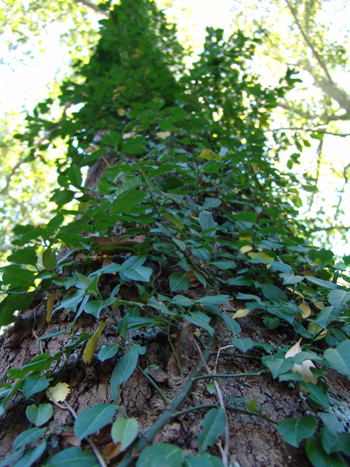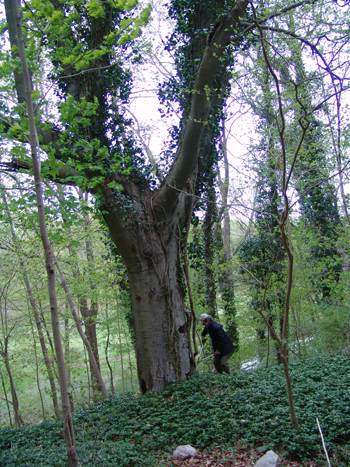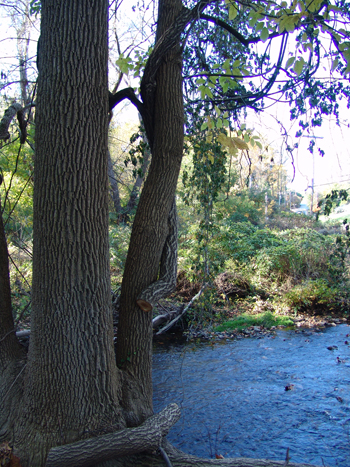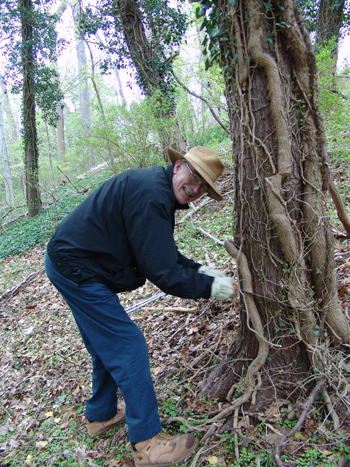Removing Invasive Vines
 April was invasive plant, pest, and disease awareness month and a great time to remove invasives on your property. As part of our annual Crum Creek Clean-Up on April 29, volunteers continued our ongoing efforts to remove and control invasives in the Crum Woods. Many large trees were liberated from the strangling vines of English ivy, naturalized wisteria, and Oriental bittersweet. Home gardeners should attempt to remove these aggressive plants from their properties as well.
April was invasive plant, pest, and disease awareness month and a great time to remove invasives on your property. As part of our annual Crum Creek Clean-Up on April 29, volunteers continued our ongoing efforts to remove and control invasives in the Crum Woods. Many large trees were liberated from the strangling vines of English ivy, naturalized wisteria, and Oriental bittersweet. Home gardeners should attempt to remove these aggressive plants from their properties as well.
Invasive vines compete with the tree they grow on for sunlight. After encircling a towering tree to reach the sunlight, the vine branches out and shades the tree’s own foliage. In addition to competing for the same sunlight, vines add weight to the tree, causing broken and damaged limbs and trunks. These aggressive vines vigorously compete and damage our native tree canopy.

Director Claire Sawyers helping to sever invasive vines growing in the Crum Woods. photo credit: R. Robert
To remove invasive plants from your property, dig them out of the ground when possible. If the vine is too large, at least, cut it off at the base of the tree. While your tree may look rough for a year or two as the vine dies and falls out, vigor will return to your specimen with the loss of the competition.
Due to the size and age of the trees and vines in the Crum Woods, volunteers focus their efforts on cutting the two to three caliber vines at the base of the trees.
In addition invasive control, 35 volunteers, staff, and students removed: 7 tires, 20 trash bags, 1 inflatable swimming pool, picnic table and parts, metal barrel, traffic barrel, pressurized wood, chicken wire, plastic ramp, sheet metal, and toilet parts. Thank you to everyone for their help!








Andrea Stephens
Posted at 08:46h, 09 MayHi! How do you dispose of the vines once you’ve cut them? Thanks!
Mary Tipping
Posted at 11:12h, 11 MayThey are composted.
Mary Tipping
Scott Arboretum
Cindy M.
Posted at 13:14h, 18 JulyDo you treat the vine stumps with glyphosate or another powerful herbicide to prevent regrowth?
Mary Tipping
Posted at 08:15h, 20 JulyCindy,
Yes. Treating the cut stump with a herbicide is the best way to control regrowth. Here’s a very good reference document regarding control of vines: https://plantscience.psu.edu/research/projects/wildland-weed-management/publications/invasive-species-quicksheets/woody-vines.
Regards,
Mary Tipping
Curator, Scott Arboretum
Tim Devaney
Posted at 09:57h, 18 OctoberYes, manually remove vines from trees. NO, do not apply glyphosate, herbicide or chemicals in the root zone, aka TPZ (Tree Protection Zone) of any tree you don’t want to risk killing. Excellent article otherwise.
Best Regards, Stay Safe,
Tim Devaney
Certified Arborist #PD- 0286
Delaware County, PA
James McKee
Posted at 07:06h, 15 MayI am engaged in removing, or stemming, the growth of this type of climbing vine. Be careful when, or if, removing the upper portion of the vine from the tree. Some of the large vines on trees can be many yards long and weigh quite a bit. As stated above though, the tree loves this removal!! Thanks for the work you do as stewards of the earth! Have a great day.
Lois Blood
Posted at 13:21h, 27 DecemberThis woody vine is all over our woods along the Susquehanna River near the New York border. It killed one of the few old large elm trees. I try ti clip it off the trees, but it’s an overwhelming task. Is there any safe weed killer? I thought about pouring vinegar around near trees to at least retard the growth. Any suggestions?
Mary Tipping
Posted at 09:43h, 11 JanuaryHi Lois,
Which woody vine are you referring to? Also, horticultural vinegar is not effective for woody plants, and can cause severe burns to amphibians if it comes in contact with their skin.
Regards,
Mary Tipping
Scott Arboretum Curator